The 1939-40 season of Merrie Melodies saw many episodes familiar to us from endless television runs, others that are more obscure with fewer runs, and, late in the season, one of the most significant cartoons of all (which we will get to in due course).
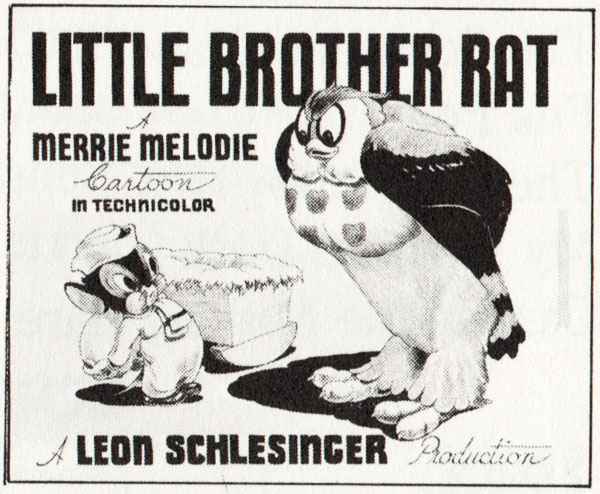
Little Brother Rat (9/2/39) – Sniffles, previously seen in “Naughty But Mice”, appears to have gotten over most of his cold without the XLNT (125% alcohol) cold cure, and seems to be very successful at obtaining dangerous things for a scavenger hunt (including a mouse trap and a cat’s whisker). Now he only has to get an owl’s egg. He does, and eventually makes friends with Papa Owl, whose mercurial temper almost gets Sniffles in trouble. Songs include “I’m Happy About the Whole Thing”, a featured song for Dick Powell and Ann Sheridan in Naughty But Nice (1939), recorded by Maxine Sullivan on Victor, Jan Savitt and his Top Hatters with vocal by Bon Bon on Decca, Lawrence Welk on Voalion, and in this surviving aircheck (below) by Barney Rapp and his Orchestra with vocal by an up-and-comer – Doris Day.
Sioux Me (9/9/39) – Essentially a Technicolor remake of “Porky the Rainmaker”, repeating several of the gags from the earlier cartoon, this time frameworked by the efforts of a bogus Indian rainmaker to please his “Chiefie” whose crops are drying out – or else. Songs include “Concert in the Park”, “We Want Rain” (an original number for the film), “April Showers” (lifted straight from the score of the Avery cartoon), and “William Tell Overture – The Storm.” That music cue early on in the film – when the chickens, pigs and buffalo are on strike – is “I Want My Share of Love” – recorded in 1939 by Artie Shaw:
Land of the Midnight Fun (9/23/39) – Another travelogue parody, and another trip to the frozen North. All of the usual tropes get trotted out once again. A surprise gag has the ship return in a thick fog to “little old New York”, and when the fog clears, it is found precariously balanced atop the pinnacle of the Trylon and Perisphere (the emblem structure of the 1939 New York World’s Fair). Songs: “The Kiss Waltz” (in a featured number parodying Sonia Henie), “All Through the Night” (an old Welsh air), “Song of the Marines”, “Over the Waves”, and “California Here I Come”.
The Little Lion Hunter (10/7/39) – A small African boy takes his spear and attempts to hunt big game. His efforts are kerflummoxed by a mystical Mynah (some titles call him “Minah”) Bird who is able to appear from and disappear to nowhere as it hops around. The film, with minor character redesigns, developed into the Chuck Jones “Inki” series. Songs: mostly classical themes including the Fingal’s Cave overture by Mendelssohn. I leave it to those more versed in classical music to name other cues. (Paul Groh, are you listening?)
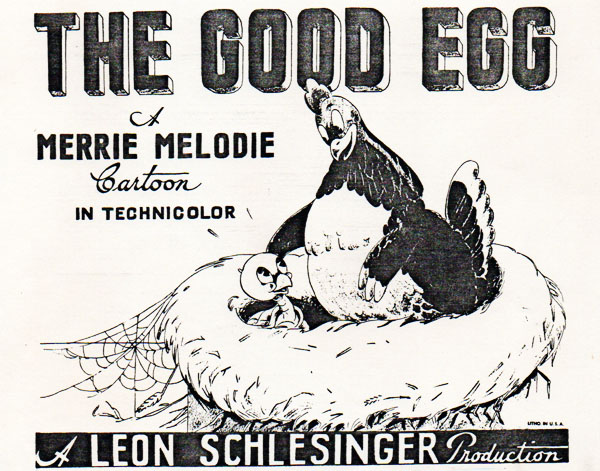
The Good Egg (10/21/39) – A frustrated hen, without eggs of her own, adopts a stray egg found in the sand, which turns out to hatch a turtle. The turtle tries unsuccessfully to mingle with the chickens, only gaining acceptance once he becomes an aquatic hero, saving the local chick population from a nautical accident in a toy boat. Songs: “Start the Day Right”, “You Don’t Know How Much You Can Suffer”, and “The Umbrella Man” (sung in chicken-ese).

Fresh Fish (12/4/39) – Spot gags underwater. A professor descends in his bathysphere in search of the “Whim Wham Whistling Shark”. Otherwise, there are piscatorial puns aplenty – including a running gag about a two-headed fish searching for “Mr. Ripley” (Robert Ripley from “Believe It Or Not”). The musical score includes “Chicken Reel” (accompanying a “Chicken of the Sea” tuna gag); “Over the Waves”; “Rocked in the Cradle of the Deep”; “Let the Rest of the World Go By” and “My Isle of Golden Dreams”, a 1919 composition which became a standard of the Hawaiian repertoire, recorded in the day by Ben (“Benny”) Selvin on Victor, Paramount and Puritan, Charles A Prince (as “Columbia Orchestra”) on Columbia, Nicholas Orlando on Pathe and Silvertone, the Joe Thomas Sax-i-Tette on Okeh, and vocally by Charles Harrison on Columbia and the Sterling Trio (Albert Campbell, Henry Burr, and John Myers) on Emerson and Medallion, and in later revivals by Roy Smeck on ARC labels, Frances Langford on Decca, Glenn Miller on Bluebird, Bing Crosby with Dick McIntire on Decca, and later the Andrews Sisters with Alfred Apaka on Decca, Dinah Shore on Victor, Vaughn Monroe on Victor, and Marty Robbins on Columbia.
Fagin’s Freshman (11/18/39) – A litttle kitten thinks his siblings’ endless repetitions of the “Three Little Kittens” song are sissy stuff, and prefers to listen to “Gangbusters” on the radio and aspire to be a little tough guy. He runs away from home, and winds up in a very urban school for young hoodlums. He gets scared when he finds out where most of this school’s “graduates” wind up – in such institutions as Sing Sing – and rushes home to join in the last verses of the “Kittens” song. Songs (besides “Three Little Kittens”) include “We’re Working Our Way Through College” with specialty lyrics, and “Rock-a-Bye Baby”.
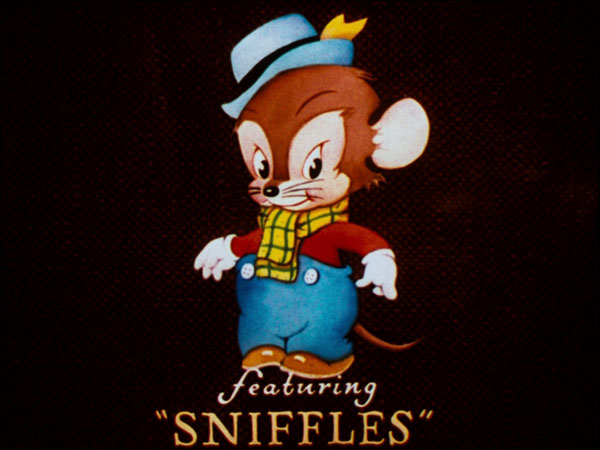
Sniffles and the Bookworm (12/2/39) – More adventures with Sniffles, the nose-blocked mouse, and his new friend, a bespectacled bookworm, in a British bookshop (you can tell because all the price tags are in shillings and pence). The worm first envisions Sniffles as an invading monster, and builds him up in pantomime to the Pied Piper and a Viking character (possibly Eric the Red) for assistance. But when these characters realize how little Sniffles really is, they break into an impromptu musical entertainment for him. Until the music disturbs the sleep of Frankenstein, leading to the inevitable chase. Songs: “Mutiny In the Nursery”, introduced in the Warner feature Going Places by Loius Armstrong, Dick Powell, Maxine Sullivan, and other members of the cast. Paul Whiteman and his Swing Wing recorded it for Decca, with vocal by the Four Modernaires, Jack Teagarden, and Joan Edwards. It was played as an aircheck by Glenn Miller on one of his broadcasts. In England, the Six Swingers recorded it for Columbia.
Screwball Football (12/16/39) – Spot gags on the gridiron – with at least one that was a little surprising to pass the Hayes office: “It looks like Stinkovich is going to get it in the end – zone!” The pistol shot ending the game comes from a juvenile spectator who’s taken revenge on another fan for taking slurps off his ice cream cone. Songs include “Frat”, “You’re In the Army Now”, “Rock-a-Bye Baby” (during the ice cream cone sequences), “The Gold Diggers’ Song”. “Funeral March”, “California, Here I Come”, and “The Kiss Waltz”
The Curious Puppy (12/30/39) – The two curious puppies (the larger of whom is acting as a guard) scamper about an amusement park after hours. Score includes “Blue Danube Waltz”, and extended theme and variation on “Where, Oh Where Has My Little Dog Gone?”. The first scenes play out under “Oh You Crazy Moon”, covered by Bob Crosby on Decca:
The Early Worm Gets the Bird (1/13/40) – a now politically incorrect cartoon about a Mammy blackbird and her four hatchlings, one of whom wants a worm so bad he vows to be the “early bird” who gets him. Mammy warns of the prowling fox and his various identifying features – especially the sharp teeth to eat little birds – and the chick eventually finds the fox to well live up to the description. The worm ultimately bails him out by luring an angry bee into the fracas, sending fox over the horizon. Our junior hero rushes back home to bed, and in the morning no longer follows the lead of his siblings in wanting worms for breakfast. In this he is joined by the worm, who is now sharing his bedding. Songs: “Ain’t We Got Fun?” and “Mammy’s Little Coal Black Rose”, a song from 1916, recorded for Victor by the Orpheus Quartet; the Broadway Quartette on Columbia, and Manuel Romain on Edison.

Mighty Hunters (1/27/40), only gets brief mention here, as the first Warner film encountered which seems to consist of all original score with the exception of a few standard riffs Stalling would recurrently use whenever he encountered Native Americans – including “Indian Dawn” by J.S. Zamecnik (below), “Sun Dance” by L. Friedman and “Indian Wedding Feast” by George J. Trinkaus. The film itself is an adaptation of the Jimmy Swinnerton strip, “Canyon Kiddies”, handsomely presented in detailed Chuck Jones Disneyesque fashion (albeit standard snail-pacing). It is the only early Blue Ribbon reissue to preserve its original title card.
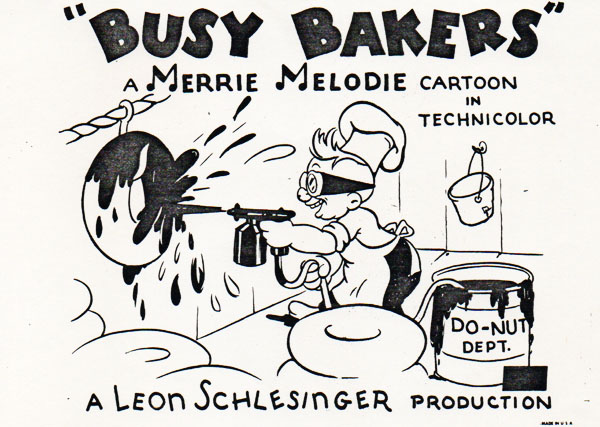
Busy Bakers (2/19/40) – A twist on “The Shoemaker and the Elves”, set here in the shop of a small town baker whose business is on the skids. An old derelict asks for a crust of bread, and is given proprietor Swenson’s last donut (with part of the chocolate coating peeling off). The derelict is in fact a baking elf in disguise, and rounds up a team of crack bakers to bail out Swenson’s establishment during the wee small hours. Next morning Swenson is “in the dough” as sales pour in, nearly cleaning out the shop. The derelict returns and again asks for a handout, this time receiving a whole pie – but with a “string” attached – a five cent deposit on the pie tin. The elf responds by throwing the pie back – in Swenson’s face. Swenson delivers curtain line to the audience: “That’s gratitude for you”. Most notable song is an original: “The Sappy Happy, Slappy Little Baker Men”, delivered in best Seven-Dwarfs’ style, which musically morphs into an extended version of “In an Old Dutch Garden”.
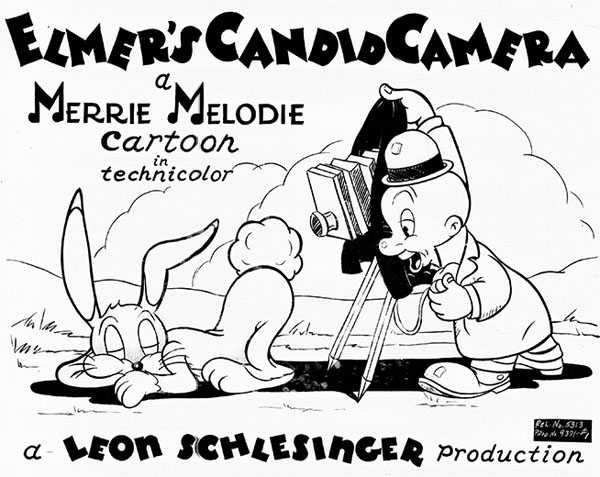
Elmer’s Candid Camera (3/2/40) – The first encounter between a fully-developed Elmer Fudd and the still developing “Bugs’” Bunny. Elmer has gotten himself some photographic equipment, and a book on “Photographing Wild Life”. He goes out into the brush, encountering the Bunny, still sounding remotely like Woody Woodpecker, and as goofy as in previous appearances, though in a slower-paced style. The Bunny drives Elmer completely bananas, causing him to smash up his photographic equipment – and Bugs to kick him into the lake with his photography book atop his head.
Songs: “What’s New” (originally titled “I’m Free”) is played over the titles and credits, was originally written by a couple of Bob Crosby’s musicians, and recorded by Crosby’s band for Decca as an instrumental. The lyric and its final title came a few months later, and was recorded by Benny Goodman on Columbia and by Ray Herbeck and his Misic With Romance on Vocalion. The song became a standard with jazzmen, who loved its chord changes and the chromatic descent of the melody. Bob’s brother Bing recorded a vocal version for Decca. Kay Kyser also got it on Columbia. It was revived as the title song of a collection of standards by Linda Ronstadt with Nelson Riddle in 1982.
Next Post: I’ll tell you “what’s new” in part 2 of 1940’s Merrie Melodies.


 James Parten has overcome a congenital visual disability to be acknowledged as an expert on the early history of recorded sound. He has a Broadcasting Certificate (Radio Option) from Los Angeles Valley College, class of 1999. He has also been a fan of animated cartoons since childhood.
James Parten has overcome a congenital visual disability to be acknowledged as an expert on the early history of recorded sound. He has a Broadcasting Certificate (Radio Option) from Los Angeles Valley College, class of 1999. He has also been a fan of animated cartoons since childhood.












































I just had another look at “The Little Lion Hunter” and can say with some confidence that all the music in the first four minutes, and in the last minute, comes from Mendelssohn, and everything in between (from the moment Inki falls out of the tree until the final march of the Mynah bird) is original Stalling. Certainly it bears all the hallmarks of Stalling’s style, such as sinuous chromatic solos lines with alternating duple and triple rhythms, copious mickey-mousing, etc. I have commented elsewhere on this site that I find Mendelssohn’s overture, composed after a rough sea voyage to the Scottish island of Staffa on his first trip to the British Isles, ill-suited to the African jungle setting.
By the way, the title of the piece is “Die Hebriden”, or “The Hebrides” in English. “Fingal’s Cave” is an alternate title assigned to a later edition of the work by Mendelssohn’s publisher. (This was a common ploy in those days to con people into buying music they already had, and it wasn’t considered particularly unscrupulous.) Nowadays the original title is generally preferred; “Fingal’s Cave” is only mentioned, if at all, in parentheses, or buried somewhere in the program notes. It’s a concert overture, as opposed to an overture that precedes an opera like “William Tell” or “The Barber of Seville”; that is, a short, self-contained, single movement work suitable for opening an orchestra concert. (Of course, many operatic overtures are popular concert pieces as well.) So one may refer to it as the “Hebrides Overture” or “Fingal’s Cave Overture”; but when the Wooster College music director called it the “overture to ‘Fingal’s Cave'”, that’s just plain wrong. It’s not an overture “to” anything.
I love this week’s selection of songs, as always. “I Want My Share of Love” is my favourite. But as for the Orpheus Quartet’s recording of “Mammy’s Little Coal Black Rose” — I’m speechless! I wonder if the Orpheus String Quartet knows about this….
I never thought “Elmer’s Candid Camera” was as bad as Chuck Jones made it out to be in later years. He had ceetainly made worse shorts before and after.
If anything, the short has great character animation, and a few good lines here and there.
“Please sir! Gosh, I don’t even know the guy!”
I’m not sure it’s apocryphal or not, but allegedly Jones once said he would burn all his shorts pre-’48 or ’49. Which just shows that sometimes an artist’s toughest critic is themselves.